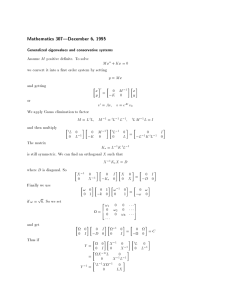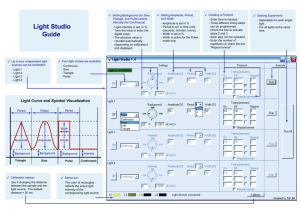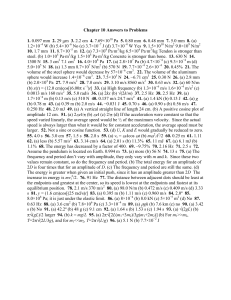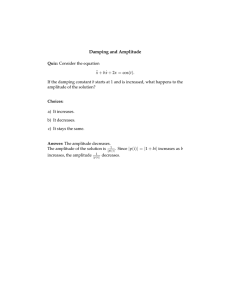On using peak amplitude and rise time for AE source characterization
advertisement
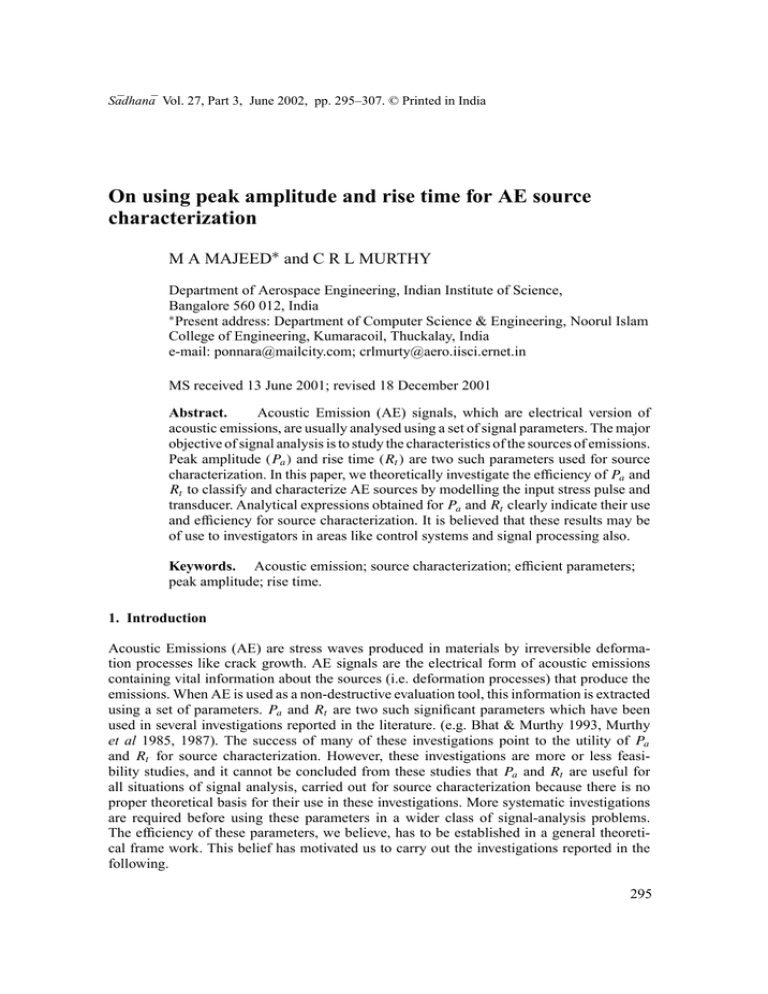
Sādhanā Vol. 27, Part 3, June 2002, pp. 295–307. © Printed in India
On using peak amplitude and rise time for AE source
characterization
M A MAJEED∗ and C R L MURTHY
Department of Aerospace Engineering, Indian Institute of Science,
Bangalore 560 012, India
∗
Present address: Department of Computer Science & Engineering, Noorul Islam
College of Engineering, Kumaracoil, Thuckalay, India
e-mail: ponnara@mailcity.com; crlmurty@aero.iisci.ernet.in
MS received 13 June 2001; revised 18 December 2001
Abstract.
Acoustic Emission (AE) signals, which are electrical version of
acoustic emissions, are usually analysed using a set of signal parameters. The major
objective of signal analysis is to study the characteristics of the sources of emissions.
Peak amplitude (Pa ) and rise time (Rt ) are two such parameters used for source
characterization. In this paper, we theoretically investigate the efficiency of Pa and
Rt to classify and characterize AE sources by modelling the input stress pulse and
transducer. Analytical expressions obtained for Pa and Rt clearly indicate their use
and efficiency for source characterization. It is believed that these results may be
of use to investigators in areas like control systems and signal processing also.
Keywords. Acoustic emission; source characterization; efficient parameters;
peak amplitude; rise time.
1. Introduction
Acoustic Emissions (AE) are stress waves produced in materials by irreversible deformation processes like crack growth. AE signals are the electrical form of acoustic emissions
containing vital information about the sources (i.e. deformation processes) that produce the
emissions. When AE is used as a non-destructive evaluation tool, this information is extracted
using a set of parameters. Pa and Rt are two such significant parameters which have been
used in several investigations reported in the literature. (e.g. Bhat & Murthy 1993, Murthy
et al 1985, 1987). The success of many of these investigations point to the utility of Pa
and Rt for source characterization. However, these investigations are more or less feasibility studies, and it cannot be concluded from these studies that Pa and Rt are useful for
all situations of signal analysis, carried out for source characterization because there is no
proper theoretical basis for their use in these investigations. More systematic investigations
are required before using these parameters in a wider class of signal-analysis problems.
The efficiency of these parameters, we believe, has to be established in a general theoretical frame work. This belief has motivated us to carry out the investigations reported in the
following.
295
296
M A Majeed and C R L Murthy
2. The approach
Our approach to studying Pa and Rt , from source characterization point of view, consists in
mathematically modelling the transient stress pulse and the transducer which converts it to
an electrical signal . This model is used to obtain analytical expressions for Pa and Rt which
are then used to study these parameters from source characterization point of view.
2.1 Stress pulse
So far it has not been possible to record an emission event or stress pulse as it leaves the
source. Neither is the physics of the wide variety of deformation mechanisms that give rise
to AE fully understood. Hence, modelling stress pulses exactly appears to be rather difficult.
However, this should not deter us from pursuing the stated goal of theoretically studying the
efficiency of Pa and Rt , as stress pulses can reasonably be assumed to be of the form of typical
transient functions fully mathematically defined in the literature. The functions used in our
investigation are listed below along with their Fourier transforms, which are available in the
signal processing literature.
(e.g. Salivahanan et al 2000)
(i) Triangular functions (figure 1):
A(1 + 2t/T ), −T /2 ≤ t ≤ 0,
iT (t) = A(1 − 2t/T ), 0 = t = T /2,
0, otherwise.
(1)
In the following the maximum amplitude A of the triangular function is referred to as
its pulse height.
Fourier transform:
sin2 (T /2)
IT (f ) = (AT /2)
.
(2)
(f T /2)2
(ii) Gaussian function (figure 2):
iG (t) = A exp(−t 2 /2σ 2 ).
(3)
Fourier transform :
I G(f ) = (2)1/2 Aσ exp[−σ 2 42 f 2 /2].
iT(t)
A
−T/2
0
T/2
t
Figure 1. Triangular function.
(4)
On using peak amplitude and rise time for AE source characterization
297
iG(t)
A
t
0
Figure 2. Gaussian function.
More than 99.87% of the total area enclosed by the Gaussian curve of (3) lies between
t = −3σ and t = 3σ . Hence, for analytical purpose, (3) can be redefined as a finiteduration function.
(
A exp(−t 2 /2s 2 ), −3σ = t = 3σ,
iG (t) =
(5)
0, otherwise.
Thus the pulse width of the Gaussian function (truncated) T = 6σ . In the sequel, by
pulse height of the Gaussian function we mean its maximum amplitude A.
(iii) Rectangular function (figure 3)
(
A,
−T /2 ≤ t ≤ T /2,
iR (t) =
(6)
0, otherwise.
Fourier transform:
IR (f ) = AT [(sin f T )/f T ]
(iv) Half cosine function (figure 4)
(
A cos(t/T ),
iC (t) =
0, otherwise.
(7)
−T /2 ≤ t ≤ T /2,
(8)
In the sequel, the maximum amplitude A is referred to as the height of the half cosine
pulse.
Fourier transform:
IC (f ) = [(2A)/(T )] (cos f T ) / (/T )2 − (2f )2 .
(9)
iR(t)
A
−T/2
0
T/2
t
Figure 3. Rectangular function.
298
M A Majeed and C R L Murthy
iC(t)
A
−T/2
0 T/2
t
Figure 4. Half cosine function.
2.2 Basis for the choice
Our choice of rectangular and triangular functions is based on the physics of the phenomenon
presented by Hill & Stephens (1974). In this model, acoustic emission is assumed to be
generated by the displacment of any defect. Three distinct phases, viz., (1) initial phase of
constant acceleration, (2) intermediate phase of steady growth - with constant velocity, and
(3) final phase of constant deceleration, are identified in the total course of the displacement
of the defect. The stress waveform derived from this defect-displacement model has the form
shown in figure 5.
A close look at the waveform suggests that if the initial and final phases are of negligible duration, then the stress waveform (figure 5) can be approximated by a rectangular function. In situations where the intermediate phase is of negligible duration compared to the other two phases, the stress waveform can be approximated by a triangular
function.
Choice of the truncated Gaussian function, (5) and half cosine function can be justified in
the light of the work by Stephens & Pollock (1971). In this, by considering the fundamental constraints that the stress wave emitted from irreversible plastic deformation of the test
specimen should satisfy, the authors propose a pulse of the form shown in figure 6 as a stress
waveform model. Two functions that resemble this model in shape are the truncated Gaussian
function and the half cosine function.
2.3 Transducer modelling
Stress
For ease of analysis, it is assumed that the transducer is a linear time-invariant system (Papoulis
1977) with ideal bandpass characteristics. Hence, frequency response H (f ) of the transducer
Defect
acceleration
Defect
deceleration
Time
Figure 5. Theoretical stress waveform from Hill &
Stephens (1974).
299
Stress
On using peak amplitude and rise time for AE source characterization
Time
Figure 6. Theoretical stress waveform from Stephens & Pollock (1971).
can be written as
(
H (f ) =
C exp(−j 2f t0 ), f1 < |f | < f2 ,
(10)
0, otherwise,
where, t0 is the transmission time or delay constant (Papoulis 1977) of the transducer and C,
a constant expressed in volts per microbar (10−1 Pa).
2.4 Transducer response to transient functions
The stress wave emitted by the source propagates through the material and is distorted when
it reaches the transducer. However, for analytical simplicity, it is assumed that the transducer
is close to the source and that the stress wave reaches the transducer just as it leaves the
source. Under this assumption and the assumption made in the previous section, the Fourier
transform G(f ) of the signal g(t) due to an input stress pulse i(t) is given by
G(f ) = I (f )H (f ),
(11)
where I (f ) is the Fourier transform of i(t). Hence,
Z +00
g(t) =
I (f )H (f ) exp(j 2f t)df.
(12)
−00
Substituting for H (f ) from (10), we get
Z −f 1
Z
g(t) = C
I (f ) exp[j 2f (t − t0 )]df +C
−f 2
f2
f1
I (f ) exp[j 2f (t − t0 )]df,
which reduces to (Papoulis 1977),
Z f2
g(t) = 2C
I (f ) cos 2f (t − t0 )df.
(13)
f1
Equation (13) can be used by substituting for I (f ), to find the transducer response to the
input stress pulses described in §2.1.
Triangular input: The output due to the triangular input defined by (1) is given by
Z
gT (t) = CAT
f2
f1
sin2 (f T /2)
cos 2f (t − t0 )df.
(f T /2)2
(14)
300
M A Majeed and C R L Murthy
iTO(t)
A
0
T/2
T
t
Figure 7. Delayed triangular function.
This represents the transducer response to a triangular stress pulse that originates at time
t = −T /2. However, for real-time measurements of signal parameters, it is more appropriate
to consider input functions that are applied to the transducer input at non-negative instances
of time. For analytical convenience, we take the origin of the time axis as the instant when
the stress pulse arrives at the transducer input. Thus, if the input is triangular, we have to find
the transducer response to an input pulse of the form shown in figure 7. It is not difficult to
see that this is same as the function shown in figure 1 and defined in (1), but shifted in time
by a factor T /2. If iT o (t) denotes this function, then
iT o (t) = iT (t − T /2).
Therefore, the output due to this stress pulse, assuming the time-invariance (Papoulis 1977)
property of the transducer is given by
gT o (t) = gT (t − T /2),
i.e.
Z
gT o (t) = CAT
f2
f1
sin2 (f T /2)
cos 2f [t − (t0 + T /2)]df.
(f T /2)2
Using the notation gT(t) to denote gTo(t), (15) may be rewritten as
Z f2
sin2 (f T /2)
gT (t) = CAT
cos 2f [t − (t0 + T /2)]df.
(f T /2)2
f1
(15)
(16)
Gaussian input: The function shown in figure 8 can be written in terms of the function defined
in (5) as
iGo (t) = iG (t − 3σ ).
iGO(t)
A
0
3σ
6σ
t
Figure 8. Delayed Gaussian function.
On using peak amplitude and rise time for AE source characterization
301
iRO(t)
A
0
t
T
T/2
Figure 9. Delayed rectangular function.
If this stress pulse is applied to the transducer input, the output gG (t), by the same line of
argument as for the triangular input, is given by
Z
gG(t) = 2(2)
1/2
CAσ
f2
f1
exp(−σ 2 42 f 2 /2) cos 2f [t − (t0 + 3σ )]df.
(17)
Rectangular input: The output signal gR(t) due to the delayed rectangular input iRo (t) shown
in figure 9 can be written as the output signal due to the rectangular input of figure 3 delayed
in time by a factor T/2. That is,
Z
gR (t) = 2CAT
f2
f1
sin f T
cos 2f [t − (t0 + T /2)]df.
f T
(18)
Half cosine input: The output signal gC (t) due to the delayed half cosine input (figure 10)
can be written as
Z
4CA f 2
cos f T
gC (t) =
cos 2f [t − (t0 + T /2)]df.
(19)
2
2
T
f 1 (/T ) − (2f )
3. Theoretical peak amplitude and rise time
Peak amplitude (Pa ) and rise time (Rt ) have been conventionally used in several AE applications, though there is no proper theoretical basis for their use, as stated in the introduction.
Hence, it is worthwhile to study the significance of Pa and Rt as parameters for source characterisation using the transducer model described in §2.3. We derive theoretical expressions
for Pa and Rt and study the efficiency of these parameters for source characterization in the
following.
iCO(t)
A
0
T/2 T
t
Figure 10. Delayed half cosine function.
302
M A Majeed and C R L Murthy
3.1 Pa and Rt for triangular input function
Suppose that sources are triangular stress pulses which originate and arrive at the transducer
input at time t = 0. The output due to such a stress pulse is given by (16) from which we get
the peak amplitude Pa (i.e. max gT (t)) as
Z
Pa = CAT
f2
f1
sin2 (f T /2)
df.
(f T /2)2
(20)
Similarly, the rise time Rt is given by
Rt = T /2.
(21)
Equations (20) and (21) are proved in appendix A.
3.2 Pa and Rt for gaussian input function
The output signal for Gaussian stress pulses (figure 7) is given by (17). Pa of this signal is
given by
Z
p
Pa = max gG (t) = 2 (2)CAσ
f2
f1
exp[−σ 2 42 f 2 /2] df.
(22)
Equation (22) can be proved along the same lines as (20). Pa occurs uniquely at t = t0 + 3σ .
Uniqueness of Pa can also be proved by the same line of arguments as for the triangular
function.
If we take, as in the case of the triangular input function, time origin as the instant when
the signal first appears at the transducer output, i.e., treating t0 = 0, we get Rt measured from
the origin as
Rt = 3σ.
Since the total duration or pulse width of the Gaussian pulse (figure 7) is T = 6σ . Hence the
equation Rt = 3σ states that Rt as measured from the beginning of the signal is equal to half
the pulse width T . That is,
Rt = T /2.
(23)
This relationship between Rt and T is the same as that between them in the case of the
triangular input, (21).
3.3 Pa and Rt for rectangular and half cosine input functions
The output signal due to the rectangular input of figure 9 is given by (18). If the pulse
width T and the upper cut-off frequency f2 are such that f2 T ≤ 1, i.e. f2 T ≤ for all
f, f1 ≤ f ≤ f2 , then sin f t/f t ≥ 0. Under this condition a closed-form expression for
Pa and Rt analogous to those for triangular and Gaussian input functions can be obtained as
Z
Pa = max gR (t) = 2CAT
f2
f1
sin f T
df,
f t
(24)
On using peak amplitude and rise time for AE source characterization
303
and
Rt = T /2.
(25)
The outputsignal for half cosine
input function of figure 10 is given by (19) and the function
cos f T / (/T )2 − (2f )2 takes the positive maximum value when f T = 0, and
crosses zero first when f T = 3/2.
Suppose that T and f2 are such that
f2 T ≤ 3/2, i.e.f2 ≤ 3/2T or T ≤ 3/2f2 .
Under this condition cos f T / (/T )2 − (2f )2 ≥ 0 for all f, f1 ≤ f ≤ f2 and hence
Pa is given by
Z
4CA f 2
Pa =
cos f T /(/T )2 − (2f )2 df,
(26)
T
f1
and
Rt = T /2.
(27)
In (25) and (27), it is assumed that the time origin is the instant when the signal first appears
at the transducer output.
4. Verification using simulated signals
Results given by (20), (22), (24) and (26) and the relation Rt = T /2 do not exist, to the
best knowledge of the present authors, in signal processing, control system, or any other
related technical literature. In order to ascertain the validity of these equations, we simulated
signals by numerically integrating (16)–(19). The procedure adopted is the Gauss–Legendre
quadrature formula which is one of the most accurate numerical integration procedures.
Gauss–Legendre approximation for the integral of any function f (x) over the interval (−1, 1)
is given by (Krylov 1966),
Z
1
−1
f (x)dx ≈
N
X
wi f (λi ),
(28)
i=1
where N is the number of points or nodes, (λi ) the zeros of the Legendre polynomial of degree
Rb
R1
N, and [wi ] the appropriate weight factors. a f (x)dx can be obtained from −1 f (x)dx by
the transformation i.e.
Z b
Z
b−a 1
b−a
a+b
f (x)dx =
f
y+
dy.
2
2
2
a
−1
The values f1 = 250 kHz and f2 = 500 kHz were mainly used to simulate the signals
using (16)–(19), the integrals were evaluated at equidistant points of 0.5 microseconds for a
maximum value of 100 microseconds. Transducer parameters defined in (10) were chosen as
f1 = 250 kHz, f2 = 500 kHz, C = 1 volt per microbar and t0 = 0. The number of nodes
N = 512 was found to be adequate because as N is increased from 48 to 512, the resulting
M A Majeed and C R L Murthy
Amplitude (mV)
304
Time
Figure 11. Signal due to a triangular
source T = 17 microseconds and A = 1
microbar.
Amplitude (mV)
improvement in accuracy is not significant. [λi ] and [wi ] were obtained as per Stroud &
Secrest (1966).
Large data bases of signals were simulated by using these four stress pulses, viz., triangular,
Gaussian, rectangular and half cosine for three different pulse heights, viz., 1, 2, and 3 microbar
and pulse widths varying from 1 to 30 microseconds. Four typical examples of these signals
are shown in figurs 11–14.
Peak amplitude for triangular and Gaussian input pulses obtained by numerically integrating (20) and (22) were found to be the same as the peak amplitude of simulated
signals, simulated using these input functions, there by proving the validity of these equa-
Time (µs)
Figure 12. Signal due to a Gaussian source
T = 10 microseconds and A = 3 microbar.
305
Amplitude (mV)
On using peak amplitude and rise time for AE source characterization
Time (µs)
Figure 13. Signal due to rectangular
source T = 5 microseconds and A =
3 microbar.
Amplitude (mV)
tions. Similarly the relation Rt = T /2 was also found to be correct in the simulated
signals.
Equations (24) and (25), for rectangular input, and (26) and (27), for half cosine input,
have been derived under the conditions f2 ≤ 1/T and f2 ≤ 3/2T respectively. This means
when f 2 = 500 kHz, these equations must be valid for t ≤ 2 microseconds and T ≤ 3
microseconds respectively for the rectangular and half cosine inputs. It was found from signals
simulated by these input functions that these equations hold good as long as these conditions
are met.
Time (µs)
Figure 14. Signal due to half cosine
source T = 5 microseconds and A = 3
microbar.
306
M A Majeed and C R L Murthy
5. Significance of peak amplitude and rise time
The relation that pulse width is twice the rise time and the equations for peak amplitude, (20),
shows that rise time and peak amplitude contain complete information about triangular source
parameters. This is obvious from (20) which can be written, by rearranging and substituting
Rt = T /2, as
"
#
Z f2
sin2 (f Rt )
A = P a/ CT
df
(f Rt )2
f1
This is true about Gaussian, rectangular (under the condition f2 ≤ 1/T ), and half cosine
(under the condition f2 ≤ 3/2T ) inputs. In brief, we can conclude from the foregoing that
peak amplitude and the rise time are significant parameters for source characterization.
6. Conclusion
Theoretical expressions for peak amplitude and rise time of acoustic emission signals are
derived. Correctness of these expressions are established using simulated signals. Inferences
drawn from these expressions justify the use of these parameters for acoustic emission source
characterization.
We thank Prof. Thomas Chacko of the languages section for going through the paper.
Appendix A
From (16) we get
Z
gT (t) ≤ CAT
f1
Z
≤ CAT
dgt (t)
= CAT
dt
f2
f1
Z
≤ CAT
f2
f2
f1
Z
f2
f1
that is,
dgT (t)
= −2CAT
dt
d2 gT (t)
= −4CAT
dt 2
|
sin2 (f T /2)
cos 2f [t − (t0 + T /2)]| df
(f T /2)2
sin2 (f T /2)
| cos 2f [t − t0 + T /2)]| df
(f T /2)2
sin2 (f T /2)
df,
(f T /2)2
sin2 (f T /2)
(d/dt){cos 2f [t − (t0 + T /2)]}df,
(f T /2)2
Z
f2
f1
Z
f2
f1
sin2 (f T /2)
sin 2f [t − (t0 + T /2)]f df,
(f T /2)2
sin2 (f T /2)
cos 2f [t − (t0 + T /2)](f )df,
(f T /2)2
(A1)
On using peak amplitude and rise time for AE source characterization
307
dgT (t)
= 0 when t = t0 + T /2,
dt
and
d2 gT (t)
< 0 at t = t0 + T /2.
dt
Hence gT (t) has a maximum at t = t0 + T /2 which is given by
Z
gT (t0 + T /2) = CAT
f2
f1
sin2 (f T /2)
df.
(f T /2)2
(A2)
By comparing (A2) with (A1) we find that gT (t) attains its upper bound, given by (A1), at
t = t0 + T /2 thus completing the proof.
Assume that we have a t = t 0 6= t0 + T /2 such that gT (t 0 ) = max gT (t) = Pa . This
implies that cos 2f [t 0 − (t0 + T /2)] = 1, for all f1 ≤ f ≤ f2 (otherwise gT (t 0 ) <
R f2
CAT f 1 {[sin2 (f T /2)]/(f T /2)2 } df = Pa ) implying that 2f [t − (t0 + T /2)] = 0
for all f1 ≤ f ≤ f2 . This is impossible and hence, our assumption is wrong and Pa occurs
uniquely at t = t0 + T /2.
We have seen that Pa occurs at t = t0 + T /2. Suppose we treat the instant when the signal
first appears at the transducer output as the time origin. This is equivalent to treating the
instant when the transient pulse is applied to the transducer as the time origin with t0 = 0.
Under this condition we get
Rt = T /2.
(A3)
References
Bhat M R, Murthy C R L 1993 Fatigue damage stages in unidirectional glass-fibre-epoxy composites:
Identification through acoustic emission technique. Int. J. Fatigue 15: 401–405
Hill R, Stephens R W B 1974 Simple theory of acoustic emission–a consideration of measurement
parameters. Acoustica 31: 225–230
Krylov V I 1966 Approximate calculation of integrals (NewYork: MacMillan)
Murthy C R L, Majeed M A, Pathak S C, Rao A K 1985 In-Flight monitoring for incipient cracks in an
aero engine mount: An approach through pattern recognition. J. Acoust. Emission 4: S147–S150
Murthy C R L, Dattaguru B, Rao A K 1987 Application of pattern recognition concepts to acoustic
emission signal analysis. J. Acoust. Emission : 19–28
Papoulis A 1977 Signal analysis (New Delhi:McGraw-Hill)
Salivahanan S, Vallavaraj A, Gnanapriya C 2000 Digital signal processing (New Delhi: Tata McGrawHill)
Stephens R W B, Pollock A A, 1971 Waveforms and frequency spectra of acoustic emission. J. Acoust
Soc. Am. 50: 904-910
Stroud A H, Secrest D 1966, Gaussian quadrature formulas (Englewood Cliffs, NJ: Prentice-Hall)
